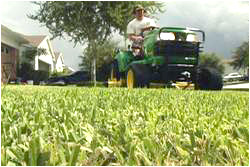Quick: Which crop, corn, wheat or lawns, is
the most watered in the United States?
The answer is lawns.
Yep, it's the green stuff growing right
outside your door, the same dewy blades you may have gingerly tiptoed
through to get this newspaper. The same sod you may feel obligated to
mow later on today, or heaven forbid, spray chemicals on to make it
greener, lusher, healthier.
You're not alone in lavishing such attention
and money on your lawn. Going to such lengths is the topic of a 27-minute
documentary that will be shown Wednesday at Central Florida Community
College. The free screening starts at 7 p.m. in the Webber Center on
campus and will be followed by a disccusion with the filmmakers.
"Gimme Green" offers "a
humorous look at America's obsession with the residential lawn and the
effects it has on our environment, our wallets and our outlook on life,"
according to the documentary's Web site.
In fact, taking care of our lawns is a $40 billion industry.
Eric Flagg and Isaac Brown, the documentary makers who will lead the
forum, made the film while working on their master's degrees in the
University of Florida's Documentary Institute.
"Water quality and availability are
critical issues in our community, where roughly half our water is used
for landscaping. Nitrates from lawn fertilizers have contributed to
the decline in groundwater quality throughout Florida," said Steve
MacKenzie, professor of environmental science and chair of CFCC's Sustainability
Task Force.
"This timely film will provide insight into the issue."
While making the film, "the biggest thing that really blew our
minds was that lawns are the largest irrigated crop," Flagg said.
"Especially in Florida, a lot of farmers have switched over to
sod. Farmers tend to grow what people really, really want."
The screening at CFCC is part of the college's look within to see how
it can reduce its environmental footprint, MacKenzie said. "We're
really looking at how we use resources in general."
The film's producers will spend Wednesday on
campus, talking to classes in the morning and then meeting with the
school's task force.
"We really want to provide leadership in this arena," MacKenzie
said.
The film premiered Feb. 18, 2007, at the Big Sky Documentary Film Festival
in Missoula, Mont., and has won numerous awards, including best documentary
in the Beverly Hills Shorts Festival in 2007, a finalist for the International
Documentary Association's 2006 David L. Wolper Award, winner of the
Academy of Television Arts and Sciences Foundation College Television
Award in 2007 and best documentary in the Oxford International Film
Festival in 2007.
The movie also has been shown on the Sundance
Channel.
Now, Flagg and Brown continue to create video projects with environmental
themes. They help environmental groups spread their messages. "A
big part of change is to have enough interesting information out there,"
Flagg said.
"Yes, doing some seemingly small,
insignificant things can help" the environment.
He recommends xeriscaping - landscaping in ways that don't require supplemental
irrigation.
"Use more native plants and native
landscaping," he added, "and use grass only where you need
it."
Flagg practices what he preaches. He has
a front yard and a backyard, but no lawn. He lets the yard do what it
wants to do. "Letting your yard go wild is really neat, to see
it change throughout the year, to see what pops up."



